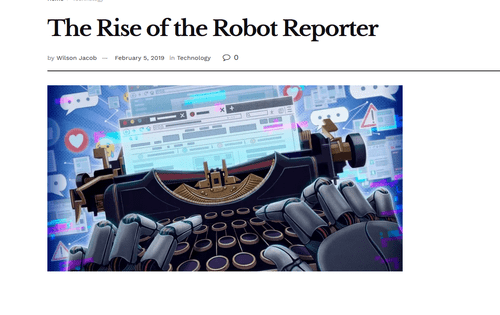
Automation: Robot Reporter Threatens Scribbler Jobs
02/06/2019
It’s hard to feel sorry for journalists losing their employment because of automation since so many of them have never been sympathetic to the job loss of American workers caused by inexpensive immigrants. But now smart machines are moving into news offices and are already cranking out articles that are heavy on numbers, like finance and sports.
It was reported in 2015 that the Argus Record went from 310 employees to 140 because of technology added in editing, layout and marketing.
The techno-trend is called “efficiency” and is supposed to allow writers to pursue more interesting subjects, but the bottom line is always the money: when machines or software can do the job more cheaply, then the humans are history.
Many experts concur that the world of work is about to change fundamentally: Oxford researchers forecast in 2013 that nearly half of American jobs were vulnerable to machine or software replacement within 20 years. Rice University computer scientist Moshe Vardi believes that in 30 years humans will become largely obsolete, and world joblessness will reach 50 percent. The Gartner tech advising company believes that one-third of jobs will be done by machines by 2025. The consultancy firm PwC published a report last year that forecast robots could take 38 percent of US jobs by 2030. In November 2017, the McKinsey Global Institute reported that automation “could displace up to 800 million workers — 30 percent of the global workforce — by 2030.” Forrester Research estimates that robots and artificial intelligence could eliminate nearly 25 million jobs in the United States over the next decade, but it should create nearly 15 million positions, resulting in a loss of 10 million US jobs. Kai-Fu Lee, the venture capitalist and author of AI Superpowers: China, Silicon Valley, and the New World Order, forecast on CBS’ Sixty Minutes about automation and artificial intelligence: “in 15 years, that’s going to displace about 40 percent of the jobs in the world.” A February 2018 paper from Bain & Company, Labor 2030, predicted, “By the end of the 2020s, automation may eliminate 20% to 25% of current jobs.”
As a result of smart machines, not only are Honduran laborers likely to become obsolete in a few years, so are H-1b foreigners working white collar jobs. It makes no sense to continue importing immigrants when the future will be automated. America will need all its remaining jobs for citizens.
It was therefore disappointing to hear President Trump endorse increased immigration during his State of the Union speech.
The original New York Times story was the basis for an unduly optimistic RT news segment, below:
The Times story was reprinted on another website, linked below, so click away if you are not a subscriber.
The Rise of the Robot Reporter, by Wilson Jacob, New York Times, February 5, 2019

As reporters and editors find themselves the victims of layoffs at digital publishers and traditional newspaper chains alike, journalism generated by machine is on the rise.
Roughly a third of the content published by Bloomberg News uses some form of automated technology. The system used by the company, Cyborg, is able to assist reporters in churning out thousands of articles on company earnings reports each quarter.
The program can dissect a financial report the moment it appears and spit out an immediate news story that includes the most pertinent facts and figures. And unlike business reporters, who find working on that kind of thing a snooze, it does so without complaint.
Untiring and accurate, Cyborg helps Bloomberg in its race against Reuters, its main rival in the field of quick-twitch business financial journalism, as well as giving it a fighting chance against a more recent player in the information race, hedge funds, which use artificial intelligence to serve their clients fresh facts.
“The financial markets are ahead of others in this,” said John Micklethwait, the editor in chief of Bloomberg.
In addition to covering company earnings for Bloomberg, robot reporters have been prolific producers of articles on minor league baseball for The Associated Press, high school football for The Washington Post and earthquakes for The Los Angeles Times.
Some examples of machine-generated articles from The Associated Press:
TYSONS CORNER, Va. (AP) — MicroStrategy Inc. (MSTR) on Tuesday reported fourth-quarter net income of $3.3 million, after reporting a loss in the same period a year earlier.
MANCHESTER, N.H. (AP) — Jonathan Davis hit for the cycle, as the New Hampshire Fisher Cats topped the Portland Sea Dogs 10-3 on Tuesday.
Last week, The Guardian’s Australia edition published its first machine-assisted article, an account of annual political donations to the country’s political parties. And Forbes recently announced that it was testing a tool called Birdie to provide reporters with rough drafts and story templates. (Continues)
